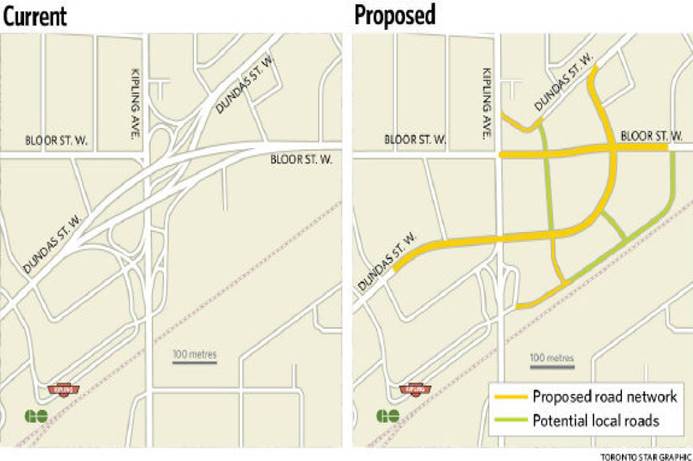
Etobicoke’s ‘spaghetti junction’ to be transformed to make room for all road users
The Six Points overpasses were completed in 1961 and were designed to maximize flow of traffic. That car-centric vision is about to change.
thestar.com
By BEN SPURR
April 3, 2017
The intersection is known as Six Points, but the name hardly captures the dizzying number of off-ramps, overpasses, and intersections that make up central Etobicoke’s notorious “spaghetti junction.”
The interchange where the major arterials of Dundas St. W., Kipling Ave., and Bloor St. W. converge has confused drivers and thwarted pedestrians for more than 50 years. Soon it will be a thing of the past.
In March, the city broke ground on the construction phase of a major project to transform the junction from a car-centric, freeway-style interchange in the core of the suburb into a “complete streets” environment that is friendly to all road users.
By the time the work crews are done in 2020,the two overpasses that traverse Kipling will have been demolished and replaced with three major at-grade intersections and a network of new streets. The reconfiguration will prioritize the safety of pedestrians and cyclists, and break down what a city assessment of the project called “a major physical and psychological barrier” between communities on either side of Kipling.
People who are familiar with the area say change is long overdue.
“This place is terrible for walking!” complained Loretta Ing, who works once a week at a nearby dentist’s office, as she made her way across the windswept Bloor overpass on Thursday.
Bajric Finkret said he often rides his bike from his home on the east side of Kipling to the Tim Hortons on the west side. The 70-year-old bikes on the sidewalk even though police have told him it’s illegal, because mixing with the fast-moving cars is too dangerous.
“I will pay if I have to pay the fine, but I will not ride my bike on this street,” he said, predicting the reconfigured interchange “will be much nicer.”
The Six Points overpasses were completed in 1961, and were designed to maximize flow of traffic with little consideration for anyone who wasn’t behind the wheel of car.
“It was geared for one road user, being the vehicular road user,” said Frank Clarizio, the city’s director of design and construction for transportation infrastructure. He said that aside from the Gardiner Expressway rehabilitation, the reconfiguration ranks among the biggest road construction projects in the city and will cost roughly $70 million.
Plans for the improved pedestrian realm include wider sidewalks, trees, street furniture, and improved access to Kipling subway station, which over the next two years is being expanded into a regional transit hub that will link the TTC with GO Transit trains and buses, as well as Mississauga bus lines.
The design also calls for physically separated bike lanes on Bloor and Dundas. (Last June, council scrapped a proposal to study bike lanes on Kipling as part of the city’s new bike plan).

A new road looping south of Bloor through the now vacant Westwood Theatre site will link Dundas on either side of Kipling. The 13.8-acre Westwood site will also eventually be home to a new Etobicoke Civic Centre, which is being relocated from its current and more remote location at Burnhamthorpe Rd. and the West Mall.
Chief city planner Jennifer Keesmaat said the Six Points reconfiguration is about much more than changing how people use the roads. The site is one of four “centres” outside of the downtown core that the city’s Official Plan targets for intensification, and the new street grid will free up roughly 15.5 acres for mixed-use development. An additional 1.75 acres could be used for parks or public art.
Keesmaat said the result will be a denser mixed-used community of residential, government, and office spaces in the heart of the suburb.
The original designers of Six Points - whom Keesmaat describes as “engineers gone wild” - saw the area as little more than a place to drive through. Breaking down the overpasses and bringing in development “is about creating a destination,” she said. “This is about recognizing that we want our suburbs to be complete communities.”
“This is actually a really profound example of transforming the city from really 1950s, 1960s kind of thinking to reinvesting and reconfiguring our infrastructure for the future city,” she said.
Councillor Justin Di Ciano (Ward 5, Etobicoke-Lakeshore), who represents the area, said he supports the reconfiguration but has “mixed feelings” about the specific design. Replacing the overpasses with signalized intersections will create a lot of“stop-and-go” for drivers, he said. The city predicts car travel times will increase by about 36.6 seconds in the morning rush hour, and 34.3 seconds in the afternoon.
Di Ciano questioned why the city didn’t consider building roundabouts instead, but the rookie councillor, who was elected in 2014, said that given the planning was more than 10 years he wasn’t about to rip up the plans.
He’s heard concerns from the local business improvement areathat the three years of planned construction court hurt the dozens of small businesses in the neighbourhood, but he said the end result will be worth it.
“It’s going to be a major construction node for a very long time,” he said, “but we’re going to see something very, very special here that west Toronto is going to benefit from in many, many ways.”
